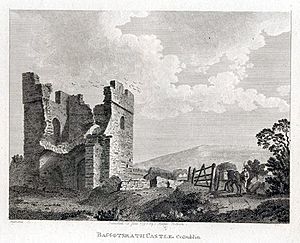Baggotrath Castle facts for kids
Baggotrath Castle, sometimes called Baggotsrath Castle, was an old castle in Dublin city centre. It was located where Baggot Street is today. The Bagod family, who later changed their name to Baggot, built it in the late 1200s. The castle was named after them.
During the English Civil War, this castle was very important. People called it "the strongest fortress near Dublin." Both sides in the war wanted to control it. The castle was mostly destroyed in 1649 during the siege of Dublin, just before the Battle of Rathmines. Its ruins stayed there until the early 1800s when Dublin Corporation tore down what was left. Today, nothing remains of the castle, but it was probably located around 44-46 Upper Baggot Street, facing Waterloo Road.
How the Castle Began
The castle and the area around it got their name from the Bagod family. Sir Robert Bagod, who was a top judge in Ireland, bought the land around 1280 and built the castle.
After the Bagods, the Fitzwilliam family owned the castle. They later became known as the Viscounts Fitzwilliam. In the early 1400s, a powerful English soldier named Sir Edward Perrers took control of the castle. But later, it went back to the Fitzwilliam family.
The castle saw a big conflict in 1441. Sir Edward Perrers' wife, Joanna, passed away. She had left the castle to her only son, but he died in 1428. Joanna chose James Cornwalsh, a high-ranking financial official, to manage her will. Cornwalsh took over the castle. However, Sir Edward Perrers' daughter, Ismay, who had married into the Fitzwilliam family, was very unhappy about this. Her husband gathered many soldiers, attacked the castle, and Cornwalsh was killed. Even though this was a very serious event, Fitzwilliam and Ismay were soon pardoned by King Henry VI's government.
In 1489, the castle was described as being in bad shape. But it was rebuilt later. By the 1640s, it was known as the strongest fortress near Dublin. However, its owners reported a lot of damage to their property in 1642.
The Castle in Wartime
In July 1649, James Butler, the Duke of Ormonde, who was a leader of the King's army, marched towards Dublin. Dublin was held by forces loyal to Parliament, led by Colonel Michael Jones. Jones expected Ormonde to try and capture Baggotrath Castle, so he partly destroyed it as a precaution.
Even so, Ormonde wanted to fortify the castle if he could. On August 1st, a group of 1500 men was sent to secure it. But for reasons that are still unclear, it took them all night to travel about a mile. When Ormonde himself arrived, he found that nothing had been done to strengthen the castle.
Meanwhile, Jones had found out about Ormonde's arrival. He attacked the castle with about 5000 men. The King's cavalry (soldiers on horseback) ran away. Most of the foot soldiers were killed or captured. This allowed Jones to move on to his big win at Rathmines.
What Happened Next
The Fitzwilliam family, who also owned another large property in Dublin called Merrion Castle, did not try to rebuild Baggotrath. The castle's ruins were described in detail by Austin Cooper in 1778. Francis Grose drew pictures of it in 1791. A few years later, what was left of the castle was torn down to make way for the extension of Baggot Street. The name "Baggotrath" is still remembered in Baggotrath Lane. This is a narrow side street that connects Lower Baggot Street with Merrion Street.


